Complete Solutions to EXAMPLE of chapter INTRODUCTION TO EUCLID'S GEOMETRY of Class 9 book with complete answers and questions
| Class 9 | MATHS |
| Chapter | INTRODUCTION TO EUCLID'S GEOMETRY |
| MODERN PUBLICATION | EXAMPLE |
| Number Of Questions | 51 |
| Academic Year | 2023-24 |
Two lines, which are both parallel to the same line, are parallel to each other, prove that.
View SolutionIf the lines AB and AC are parallel to a line l, show that the points A,B and C are collinear.
View SolutionThe following statement is true or false ? Give reasons for your answer : Only one line can pass through a single point.
View SolutionWhich of the following statements are true and which are false? Give reasons for your answer

There are in infinite number of lines which pass through two distinct points.
View SolutionWhich of the following statements are true and which are false? Give reasons for your answer

A terminated line can be produced indefinitely on both the sides.
View SolutionWhich of the following statements are true and which are false? Give reasons for your answer

If two circles are equal, then their radii are equal
View SolutionWhich of the following statements are true and which are false? Give reasons for your answer

In fig. if AB=PQ and PQ=XY, then AB=XY.
View SolutionGive a definition for each of the following terms. Are three other terms that need to be defined first? What are they, and how might you define them?
parallel line?
View SolutionGive a definition for the following term. Is there other term that need to be defined first ? What is it and how might you define it ? Perpendicular Lines.
View SolutionGive a definition for the following term. Is there other term that need to be defined first ? What is it and how might you define it ? Lines Segment.
View SolutionGive a definition for each of the following terms. Are three other terms that need to be defined first? What are they, and how might you define them?
parallel line?
View SolutionGive a definition for the following term. Is there other term that need to be defined first ? What is it and how might you define it ? Square.
View SolutionConsider ‘postulate’ given below. Given any two distinct points A and B, there exists a third point C which is between A and B. Do this postulate contains any undefined term ? Is this postulate consistent ? Do they follow from Euclid’s postulate ? Explain.
View SolutionConsider ‘postulate’ given below. There exist at least three points that are not on the same line. Do this postulate contains any undefined term ? Is this postulate consistent ? Do they follow from Euclid’s postulate ? Explain.
View SolutionIf a point C lies between two points A and B such that AC = BC, then prove that `AC=1/2AB`. Explain by drawing the figure.
View SolutionShow that every line segment has one and only one middle point.
View SolutionIn fig. if AC=BD, then prove that AB=CD

View SolutionWhy is axiom 5, in the list of Euclid’s axioms, considered as a ‘universal truth’ ?
View SolutionHow would you rewrite Euclid’s fifth postulate so that it would be easier to understand ?
View SolutionDoes Euclid’sfifth postulate imply the existence of parallel lines ? Explain.
View SolutionEuclidean geometry is valid only for curved surfaces.
View SolutionThe boundaries of the solids are curves.
View SolutionWrite True or False and Justify Your answer The edges of a surface are curves.
View SolutionThe things which are double of the same thing are equal to one another.
View SolutionIf a quantity B is a part of another quantity A, then A can be written as the sum of B and some third quantity C.
View SolutionThe statements that are proved are called axioms.
View Solution‘‘For every line `l` and for every point P not lying on a given line `l`, there exists a unique line `m` passing through P and parallel to `l`” is known as Playfair’s axiom.
View SolutionTwo distinct intersecting lines cannot be parallel to the same line.
View SolutionAttempts to prove Euclid’s fifth postulate using the other postulates and axioms led to the discovery of several other geometries.
View SolutionTwo salesman make equal sales during the month of August, in september, each salesman doubles his sale of the month of August. Compare their sales in September.
View SolutionIt is known that x+y=10 and that x=z. show that z+y=10?
View SolutionLook at the fig.
 show that AH> sum of lenghts of AB+BC+CD
show that AH> sum of lenghts of AB+BC+CD
View SolutionIn the fig. we have AB=BC,BX=BY. Show that AX=CY.
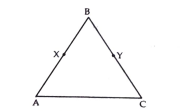
View SolutionIn the fig. we have X and Y are the mid points of AC and BC and AX=CY. Show that AC=BC
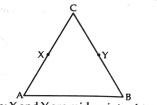
View SolutionIn the fig. we have `BX=1/2AB`, `BY=1/2BC` and AB=BC. Show that BX=BY
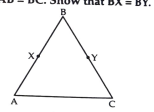
View SolutionIn the fig. we have `angle1=angle2, angle2=angle3`. Show that `angle1=angle3`
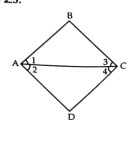
View SolutionIn the fig. we have `angle1=angle3` and `angle2=angle4`
show that `angleA=angleC`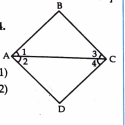
View SolutionIn the fig. we have `angleABC=angleACB` and `angle3=angle4` show that `angle1=angle2`

View SolutionIn the fig. we have AC=DC,CB=CE
show that AB=DE
View SolutionIn the fig. if `OX=1/2XY, PX=1/2XZ` and OX=PX show that XY=XZ
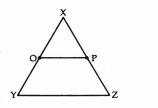
View SolutionIn the fig.
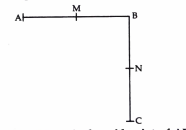
BM=BN, M is the mid point of AB and N is the mid point of BC. Show that AB=BC
View SolutionIn the fig.

BM=BN, M is the mid point of AB and N is the mid point of BC. Show that AB=BC
View SolutionShow that the angles of an equilateral triangle are `60^@` each.
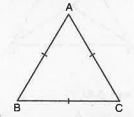
View SolutionTwo distinct intersecting lines cannot be parallel to the same line.
View SolutionIf a transversal intersects two parallel line then corresponding angles are an necessarily equal.
View SolutionIf a transversal intersects a pair of lines in such a way that a pair of alternate angles are equal, then two lines are ......... .
View SolutionIf two lines intersect, then vertically opposite angles are......... .
View SolutionIf a ray stands on a line, then the sum of angles so formed is equal to `10^@`. Is this system of axioms consistent? Justify your answer.
View SolutionThe things which are double of the same thing are equal to one another.
View SolutionIf equals are added to equals the wholes are equal.
View SolutionThe things which are double of the same thing are equal to one another.
View Solution
EXAMPLE questions and complete solutions for chapter INTRODUCTION TO EUCLID'S GEOMETRY of MODERN PUBLICATION of Class 9